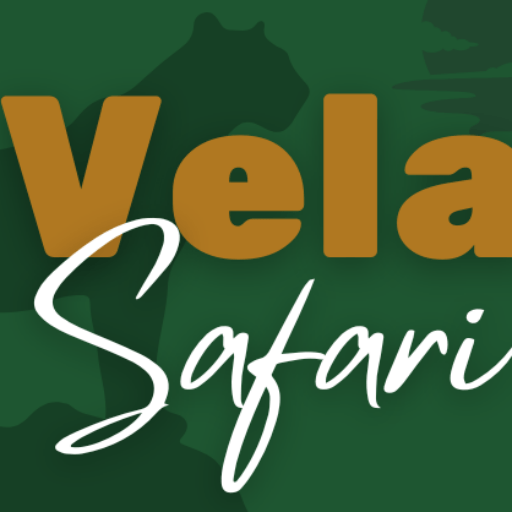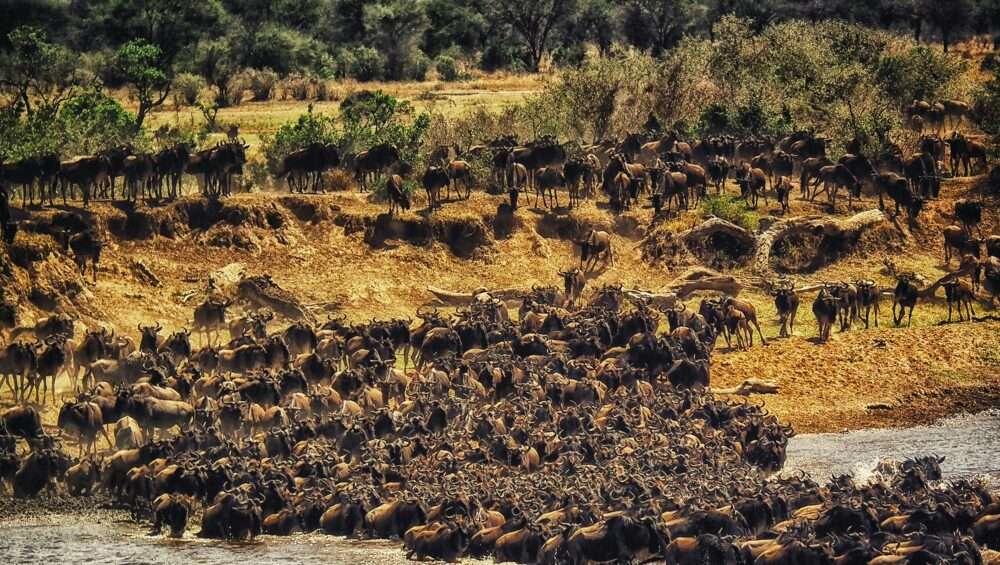Introduction to Nature’s Greatest Show
The Great Wildebeest Migration is the largest mammal migration on Earth, often called “The Greatest Show on Earth.” Each year, over 1.5 million wildebeest, accompanied by 250,000 zebras and 400,000 gazelles, complete an 800-kilometer circular journey through Tanzania’s Serengeti and Kenya’s Masai Mara. This relentless cycle of life and death is driven by ancient instincts to find fresh grazing and water.
The Migration Cycle: Month-by-Month Guide
January-March: Calving Season in Southern Serengeti
- Location: Ndutu Plains and Ngorongoro Conservation Area
- Key Event: Birth of 400,000+ wildebeest calves (8,000 born daily!)
- Wildlife Action:
- Predators take advantage of vulnerable newborns
- Excellent cheetah sightings
- Why Visit: Witness the circle of life with adorable calves taking first steps
April-May: The Long Rain Migration
- Location: Central Serengeti moving west
- Key Event: Herds form mega-groups of 100,000+ animals
- Challenge: Heavy rains make roads difficult
- Reward: Lush green landscapes with fewer tourists
June: Grumeti River Crossing
- Location: Western Corridor
- Drama: Crocodile-infested river crossings
- Unique Aspect: Fewer visitors than Mara River crossings
- Photography Tip: Capture the action at Turner Springs
July-October: Mara River Crossings (Peak Season)
- Location: Northern Serengeti
- The Main Event:Heart-stopping river crossings
- Animals face Nile crocodiles and strong currents
- Many drownings create feeding frenzies
- Viewing Tips:
- Stay at least 3 nights to witness multiple crossings
- Best lodges: Serengeti Mara River Tented Camps
November-December: Return to the South
- Location: Moving from Kenya back to Serengeti
- Behavior: Herds disperse across Loliondo and Lobo areas
- Advantage: Lower prices and fewer crowds
- Special Sight: Dust clouds from marching herds visible for miles
Why This Migration is Unique
- Sheer Scale:
- 1.5 million wildebeest = population of Philadelphia
- Herds can stretch 40km long
- Predator Paradise:
- 3,000 lions follow the migration
- Spotted hyenas and leopards feast on weak animals
- Ecological Importance:
- Wildebeest droppings fertilize 10,000+ tons of grass daily
- Their paths create water channels used by other species
Best Ways to Experience the Migration
1. Classic Game Drives
- Pros: Affordable, great for photography
- Best For: First-time visitors
- Tip: Book a private vehicle for flexibility
2. Hot Air Balloon Safaris
- Cost: 500−500−600 per person
- Magic: Silent floating over massive herds at sunrise
- Where: Seronera or Mara River areas
3. Walking Safaris
- Thrill: Tracking migration on foot
- Safety: Always with armed guides
- Best Areas: Serengeti wilderness zones
4. Mobile Tented Camps
- Advantage: Move with the herds
- Luxury Options: &Beyond’s Under Canvas
- Authentic Choice: Nomad Tanzania’s Serengeti Safari Camp
Migration Safari Costs
| Experience | Price Range (per person) |
|---|---|
| Budget Camping Safari | 250−250−350/day |
| Mid-Range Lodge Safari | 400−400−700/day |
| Luxury Mobile Camp | 800−800−1,500/day |
| Private Guided Safari | 1,000−1,000−2,000/day |
Includes: Accommodation, meals, game drives, park fees
Expert Tips for Migration Viewing
- Timing is Everything
- River crossings most likely July-Sept
- Book 12+ months ahead for peak season
- Position Yourself Right
- Stay at Mara River camps for crossings
- Use guides with radio networks to locate herds
- Photography Gear
- Bring 400mm+ lens for action shots
- Pack dust-proof camera bags
- Patience Pays Off
- Crossings may take hours to start
- Animals often turn back multiple times
Conservation Challenges
- Climate Change: Altering rain patterns
- Poaching: Snares kill migrating animals
- Habitat Loss: Expanding human settlements
How to Help:
- Choose eco-friendly tour operators
- Support Serengeti conservation programs
- Visit during shoulder seasons to reduce pressure
The Circle of Life Continues
This ancient migration has occurred for millions of years, with wildebeest following the same routes their ancestors traveled. Witnessing it today remains one of the most profound wildlife experiences on Earth – a true testament to nature’s enduring power.
Best Time to Book: Now! Prime migration viewing dates sell out over a year in advance.
Pro Tip: Combine your migration safari with Ngorongoro Crater and Zanzibar for the ultimate Tanzanian adventure.

